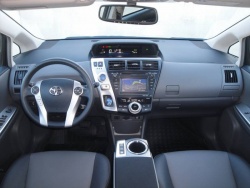 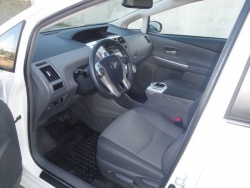 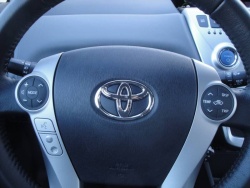 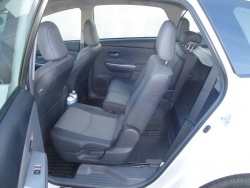 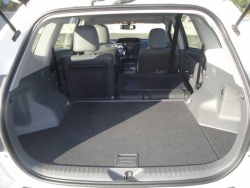 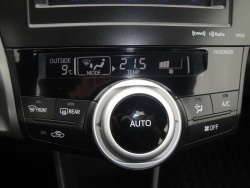 2012 Toyota Prius V. Click image to enlarge |
Hidden at the bottom of the raised centre console is a slide-out cupholder. It’s in addition to the one on top of the console next to the buttons for the three drive modes, EV, Eco and Power. Another cupholder slides out of the dash near the front passenger window, and there are two more at the rear of the centre console.
Underneath the padded centre armrest is a roomy storage area with a removable tray.
Our test car had the new water and stain-resistant synthetic leather upholstery called SofTex in a nice two-tone colour combination. The SofTex comes as part of the $6,150 Touring Package option which also includes 17-inch tires and alloy wheels, LED headlights and headlight washers, fog lights, front and rear skylights, heated front seats, XM satellite radio, navigation system, and remote door unlocking with touch-sensitive door handles.
The twin sunroofs do not open but they do allow more light into the cabin. Power operated retractable sunshades can shut out the light but they are not completely opaque.
The driver’s seat includes a manual height adjustment and power lumbar and we found it quite supportive and comfortable on long drives. The small steering wheel is positioned quite low and adjusts for length and height to suit various driver sizes. The steering wheel’s left spoke has controls for audio volume, channel seek, media mode, and telephone, and on the right for temperature adjustment, air recirculation, and an info button that displays range, current fuel economy, and average fuel economy in the top display.
The cabin has seven airbags including a knee airbag for the driver and a new front seat design that helps lessen the possibility of whiplash injury.
Driving impressions
While there’s no doubt the Prius V has plenty of cargo space and terrific gas mileage, its driving dynamics lag behind cars like the VW Golf Wagon and Ford Escape Hybrid. Simply put, the Prius V is not much fun to drive. As a practical, reliable, economical transportation solution, the Prius V is a winner, but it won’t get you excited.
When starting the Prius V, you simply press the Power button and a Ready light comes on. Most of the time, the gas engine will fire up, but sometimes you can just pull away on electric power. The small transmission lever must be moved from the right to the left and down into D mode. However, the lever automatically pops back up into the centre position, so that when turning off the ignition, the lever must be moved into Neutral which can be difficult because it’s so sensitive – this is no Hurst shifter! Then the driver must press the Park button and then press the Power button – it seems one step too many!
Accelerating in Normal mode feels slow – Toyota says it will do 0 to 60 mph in 10.4 seconds. In ‘Eco’ mode, acceleration feels downright lethargic, and we felt it was putting us at risk of being shunted from behind. Pressing the ‘Power’ mode button makes the Prius V feel more responsive in the middle of the power range, but not overly exciting. Putting the transmission in B mode acts like a low gear, slowing the car down and recharging the battery at the same time.
The engine and CVT maintain a constant drone as you accelerate but settle down to a quiet background buzz while cruising. It’s actually quite a pleasant cruiser. Like the Prius, the Prius V is supposed to run on battery power alone in slow traffic, but we found that even a minor press on the accelerator will start the engine going. Pressing EV mode can give short bursts of electric-only power on flat surfaces, but it’s not long before the battery charge gets depleted and the engine cuts in. We found that electric-only mode worked best in stop-and-go city traffic where speeds were slow and minimal acceleration was required. The automatic stop/start system isn’t obtrusive but you can tell when it starts and stops by the sound of the engine.
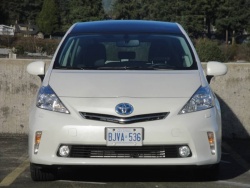 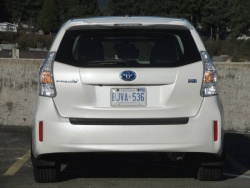 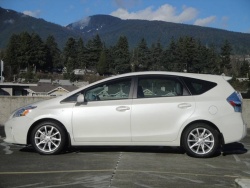 2012 Toyota Prius V. Click image to enlarge |
The Prius V’s electric power assisted rack and pinion steering feels lifeless and requires little effort, but it firms up a bit at higher speeds for precise steering control and stable tracking. The turning circle with the standard 16 inch tires is just 36.1 feet but with the optional 17 inch tires, it rises to 38.1 feet.
Handling feels stable and secure but rather uninspired with limits that are hard to gauge – there’s nothing sporty about it at all. As the Prius V is expected to carry more passengers and cargo, Toyota developed a new “Pitch and Bounce Control” that uses the wheel-speed sensors in tune with the suspension to help suppress bounce and toss motions. Without a full load, we found the ride very comfortable though a bit firm over pavement heaves and sudden bumps.
Like all Toyota models, the Prius comes with standard stability control, traction control, anti-lock brakes, electronic brake-force distribution and brake assist. It also features Toyota’s brake-override system, and tire pressure monitoring system. Optional in the Touring and Technology Package is a Pre-Collision System (PCS) that retracts seatbelts and applies the brakes in certain conditions when a frontal crash is unavoidable. It works with the optional Dynamic Radar Cruise Control.
Perhaps the most improved mechanical feature is the brakes which don’t grab as much as the brakes used to in earlier Prius’. Due to their built-in regenerative battery charging feature, the brakes in hybrids and electric cars usually feel quite grabby and sensitive, but these brakes felt almost normal.
The driver’s outward visibility is generally good except that the right rear head restraint blocks the right-side third window, making it difficult to change lanes.
My test car had 2,455 kilometres on it, and the average fuel consumption display was showing 6.9 L/100 km. The best single trip average I saw was 5.8 L/100 km. Considering this test car has been driven by a variety of aggressive journalist test drivers and is still a low mileage car, the higher figures may be understandable. Typical city/highway use should be in the mid 5 L/100 km range, according to the EPA.
Interestingly, many Vancouver city cab drivers drive Prius hatchbacks hundreds of thousands of kilometres in all sorts of weather and report averages of about 6 L/100 km. We expect they will be looking closely at the roomy Prius V when it’s time for those older Prius’ to retire.
|
Pricing: 2012 Toyota Prius V
Specifications
Competitors
Crash test results
|











